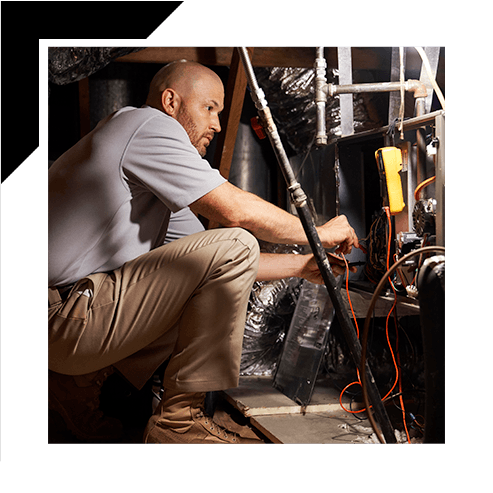
If you are in the market for a new furnace, you have a multitude of choices to choose from. Factors that will impact your decision include location, fuel source availability, and the size of your home. At Velox Air, Inc., we walk you through the various categories of furnaces.
The Basics of a Furnace
Furnaces can use a variety of energy sources to heat your residence and give you comfort. The warm air enters your indoor space via the ductwork in your heating unit. Usually, we install a furnace in the basement, crawlspaces, attics, and closets.
To get the right furnace, you can consult us based on your heating needs and home size. Choosing and installing the correct size of furnace for your home ensures maximum energy efficiency and life span of the system.
Furnaces by Fuel
Furnaces use either oil, gas, electricity, or propane to operate. The furnace that you choose will partly depend on your budget and fuel source availability. The following discusses the different types of furnaces based on their fuel type.
Natural Gas Furnaces
Natural gas furnaces are economical, energy-efficient, and kind to the environment. You don’t have to worry about air pollution since natural gas burns clean. You can get a constant fuel supply from a pipe via a municipal line.
Natural gas furnaces are efficient, and you only need a small amount to heat your indoor space. Natural gas is more affordable and generally more widely available as compared to other fuel types. Plus, natural gas furnaces are durable and require minimal maintenance. Repairs are pocket-friendly; hence, you don’t have to fret about added expenses.
Oil Furnaces
Oil furnaces are less efficient than gas furnaces, and oil can be quite costly. You need a tank to store the oil that runs the furnace. When you decide to buy an oil furnace, you will need to cater to regular maintenance due to ash buildup and soot that accumulates on the furnace as a result of the combustion of the oil. Our experts can change the oil filters and clean the chimney as part of tune-up activities.
Usually, the upfront costs of purchasing an oil furnace are lower, but the operating costs can be quite high when you factor in the regular and frequent maintenance that is required. Homeowners in the North-Eastern part of the United States prefer oil furnaces since they do not have access to natural gas and have an abundance of oil resources.
Electric Furnaces
As the name implies, this type of furnace uses electricity to operate and heat your residence. Electric furnaces come at reasonable rates but aren’t as cheap to operate as their gas counterparts. While electric furnaces are very efficient at converting energy into heat, the prices of electricity are high. You will pay for energy bills at the end of every month, and the expenses can be high. Electric furnaces are typically small and can fit into small spaces if you have limited room. Electricity is readily available, and you don’t need expensive pipework to access it.
Electric furnaces are long-lasting and need minimal maintenance. Tune-ups once a year ensure that the furnace is working optimally. You can benefit from clean air in your home free from toxic fumes and potentially deadly carbon monoxide leaks.
Propane Furnaces
Propane is a byproduct of gas and oil that you can use to run your furnace. Propane is stored in tanks outside the home that need to be refilled. The benefit that comes with propane is that when it burns, it produces more heat than other fuels. Thus, you only need to utilize a minimal amount to warm your home.
Numbers show that 10% of American households use propane furnaces. They might not have access to gas or oil due to living in a remote area. Others may choose propane due to its high heat energy output.
Furnace by Operation
Furnaces distribute warm air using blower motors that operate at specific speeds during the cold months. Also, blower motors participate in cooling your space when it’s summertime. There are several types of furnaces that operate with different blower motor functions, which ultimately determines their efficiency at distributing warm air and the amount of energy they use.
Single-Stage Furnaces
Single-stage furnaces have one valve resulting in one operation. Single-stage furnaces operate at one consistent speed while they work to warm your home. They are the cheapest to buy and install but are also the least efficient in terms of distributing warm air and maintaining a consistent temperature.
Depending on the size of your home you may experience hot and cold spots with a single-stage system. Single-stage furnaces can also be noisy compared to two-stage and modulating furnaces since they have only one operating speed, which is usually high.
Two-Stage Furnaces
Two-stage furnaces control heat flow using half-speed and full-speed power depending on the demand and temperature within the home. This ability to change the power output makes two-stage furnaces more energy efficient than their single-stage counterparts. When it’s slightly cold, the furnace collaborates with the thermostat to use the half-speed setting, which conserves energy while still maintaining a comfortable temperature. As it gets colder, the elements change to full-speed power to maintain the temperature within your home.
Two-stage furnaces distribute warm air evenly, giving you the utmost comfort. Temperatures are consistent, and you can set it at half speed for a quiet operation.
Modulating Furnaces
Modulating furnaces are costly, but the energy-saving benefits that come with them make the purchase worth every penny. Also known as condensing furnaces, modulating furnaces regulate the gas input via a modulating gas valve to attain the desired temperature. The result is maximized efficiency.
This type of furnace also utilizes a variable-speed blower motor that runs at speeds determined by heating demand. This reduces the overall noise and offers continuous airflow.
The secondary heat exchanger is what makes modulating furnaces so efficient. This feature takes all heat energy that is left from the combustion of gases from the primary heat exchanger. This allows the furnace to use as much energy from the fuel combustion processes as possible.
Variable Speed Furnaces
Variable-speed furnaces adjust speed and heat depending on indoor and outdoor temperatures. This type of furnace is expensive upfront, but they have massive energy savings. They work by monitoring temperatures in your home and automatically change the speed of the blower motor.
The ability to change the blower speed based on heat demand is what makes this type of furnace an energy-efficient choice.
Conclusion
At Velox Air, Inc., we offer various HVAC services, including repairs, tune-ups, and installation. We can help you pick the right furnace based on your heating needs. Your budget will also factor in as we recommend to you the furnace to purchase.
Contact us today for more details about furnaces. We also offer comprehensive cooling services and in the Phoenix Metro area. We are also experts in boosting your indoor air quality.





